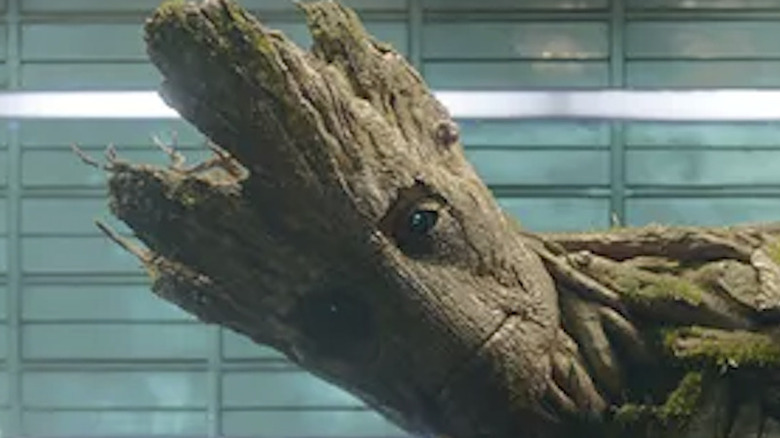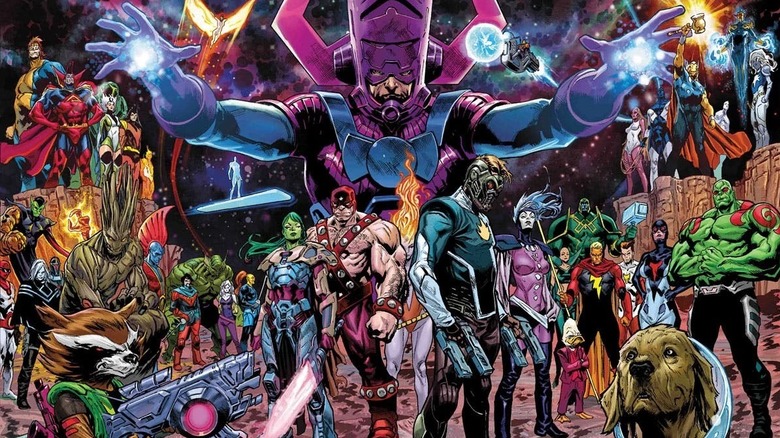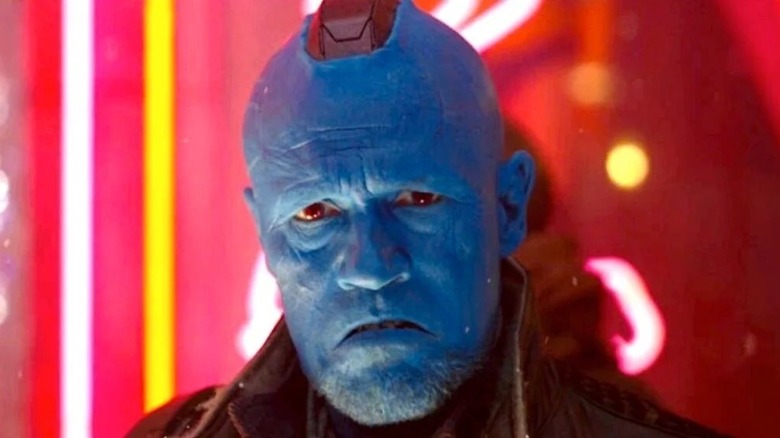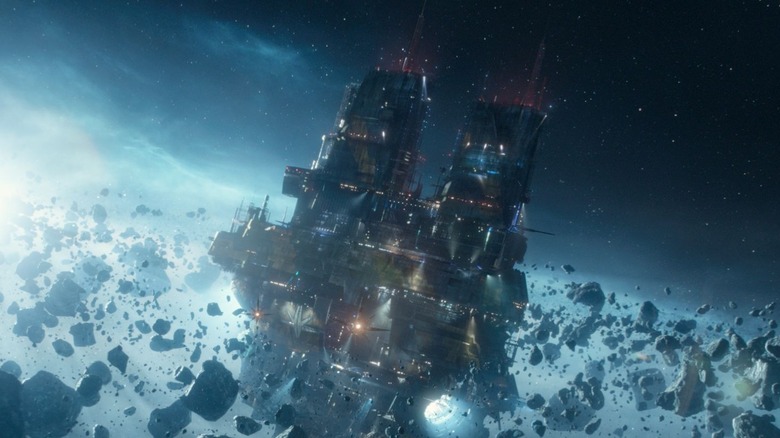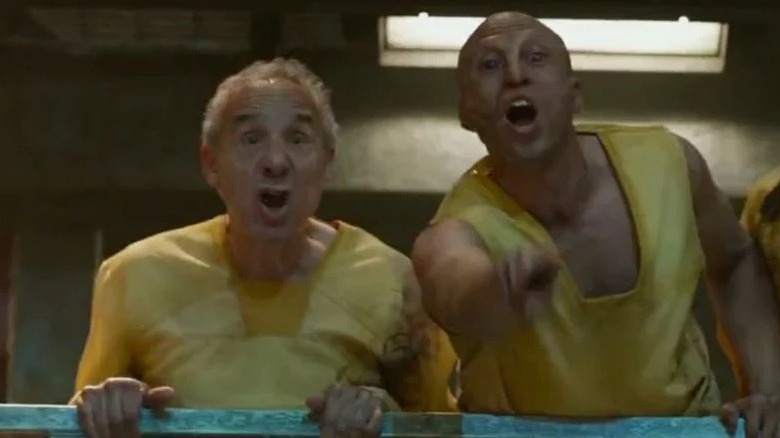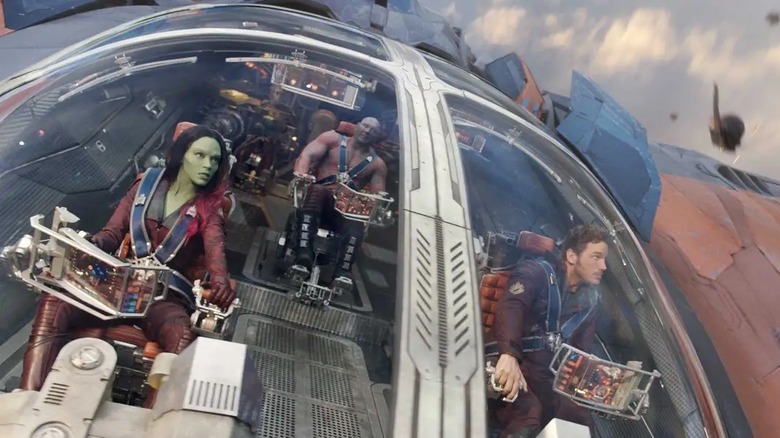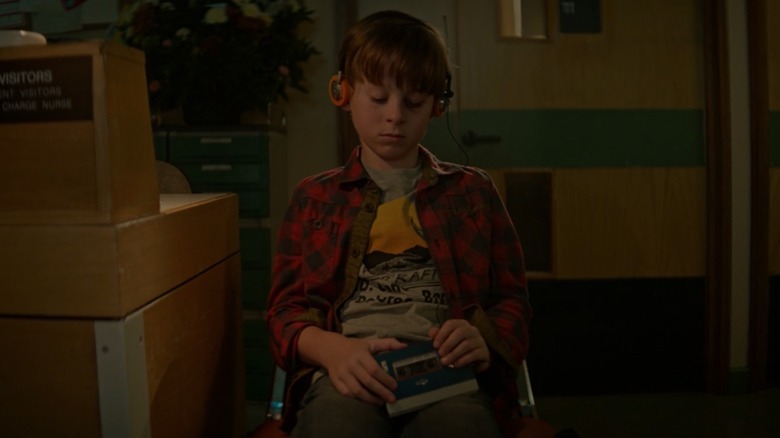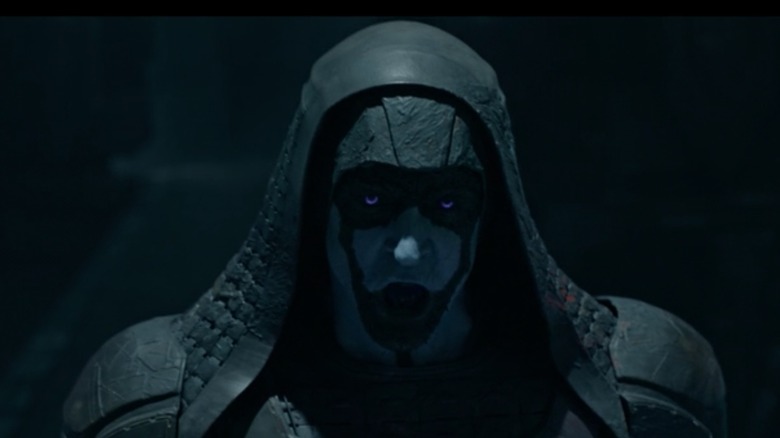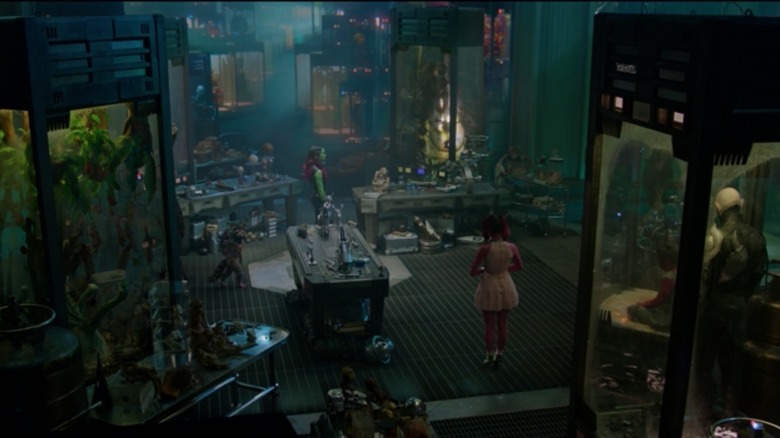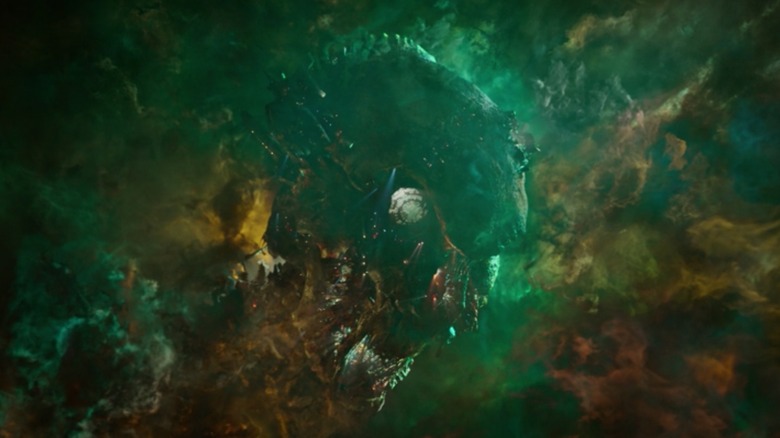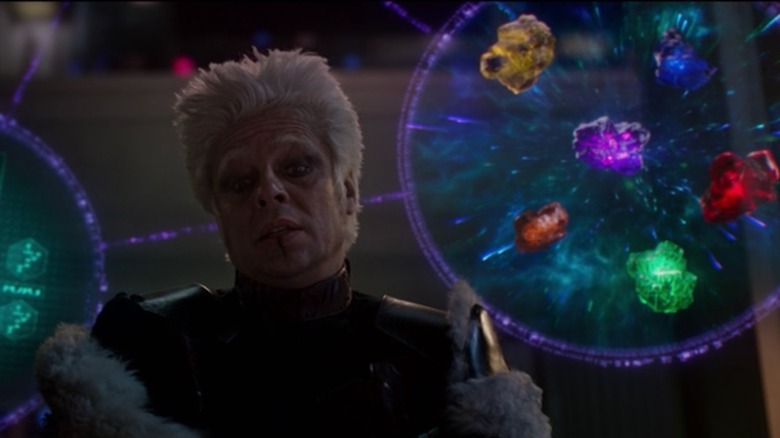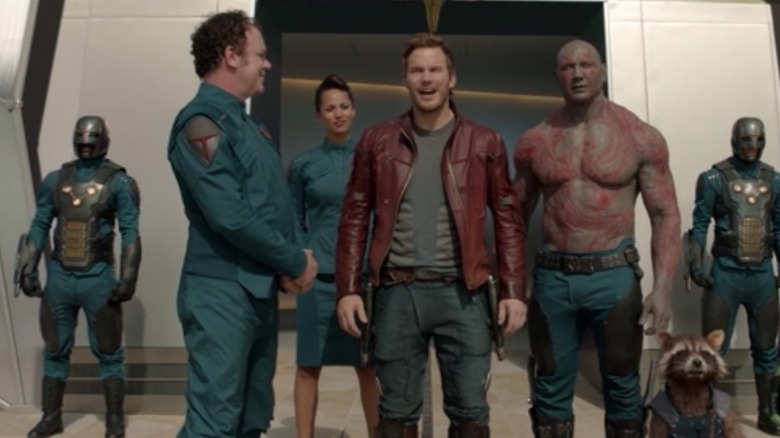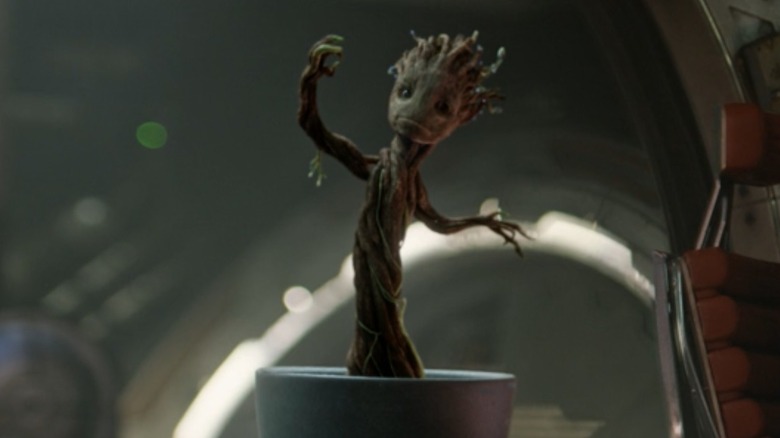Small Details Only True Fans Noticed In Guardians Of The Galaxy
Today, it seems like the whole world knows how cool Star-Lord (Chris Pratt), Gamora (Zoe Saldana), Drax (Dave Bautista), Rocket (Bradley Cooper), and Groot (Vin Diesel) are. However, when it was initially announced that Marvel Studios was making plans to bring the Guardians of the Galaxy to the big screen, many observers found it puzzling. Not only had the team's name originated with a fairly confusing, alternate future group in the late '60s, but the squad they were intending to portray on the big screen had only really been established a few years prior in a comic that lasted barely two years.
But ultimately, the resulting tale of five damaged loners coming together to see beyond themselves and save scores of planets from deranged lunacy touched an almost primal level with audiences, immediately elevating the Guardians to a cinematic status previously held by such household names as Hulk, Thor and Captain America. Somehow, this James Gunn film starring a couple green people, the guy from "Parks and Recreation," and a raccoon hit so hard with audiences that it earned just over $773 million worldwide.
With a sequel that followed a few years later, numerous side appearances by the Guardians in other MCU properties, and an upcoming holiday special and third film, it feels like the perfect time for the Guardians to once again come and get some love. With that in mind, here's a guide for those who want to look back on the 2014 classic original film and discover more of the small details that make it so delightfully, quirkily memorable.
All the d'ast toys to play with
Gunn's "Guardians" came together in the second phase of the Marvel Cinematic Universe, following Iron Man, Thor, Captain America, Hulk and the others with solo films that foreshadowed and then coalesced with 2012's "The Avengers."
With "Guardians' immediately preceded by "Iron Man 3," "Thor: The Dark World," and "Captain America: The Winter Soldier," writers Nicole Perlman and James Gunn were given permission to play with just about every available piece of the expansive Marvel space characters and ideas. The cosmic comic crew has history going all the way back to the universe-shaping initial run of "Fantastic Four" by Stan Lee and Jack Kirby, but was greatly expanded throughout the following decades. After a bit of a fallow period in the late '90s/early '00s, they were rejuvenated once more with the 2006 limited series "Annihilation," which is rumored to be in consideration itself to become a major storyline in the Marvel Cinematic Universe.
Gunn and Perlman went in a variety of different directions with some of the characters. Groot, Rocket, and Gamora are pretty close to the comics, Drax's story has been greatly streamlined, and Quill was made to be a more roguish character. As the story progresses, you can see and hear all sorts of love for the sequential forefathers, though. Alien races like the Badoon get mentioned, but Rocket can also be heard using Marvel space swear words like "d'ast." The best part is that, even after all these years, new references seem to pop out with each rewatch.
Yondu is a nod to the OG Guardians
The original Guardians of the Galaxy debuted back in 1968's "Marvel Super-Heroes" #18 and presented a new reality that has since been dubbed Earth-691 (the standard Marvel Universe is Earth-616). On that world, the heroes we know and love attempted to stop a Martian invasion and failed. Life carried on and humanity spread to the other planets in the solar system, but had to be genetically altered to survive. Some of these individuals — Charlie-27, Vance Astro, Martinex, and Yondu — came together as the original Guardians of the Galaxy to stop another invasion, this time by the Badoon.
That Yondu hailed from a fairly primitive society on a planet called Centauri-IV. He did, however possess a prominent red fin on his head and considerable archery skills. The arrows he shoots are hewn from yaka, a material that responds to sounds, including whistles, allowing for far more control than the standard shafts. While the version of Yondu played by Michael Rooker in the "Guardian" films is very different character-wise, he still looks like the comic version and controls his own yaka arrow with the red control unit on his head that looks like a toned-down mohawk.
The version of the fin seen in "Guardians of the Galaxy Vol. 2" draws an even closer comparison to the original. In a move to tie the comics and films together even more, Marvel introduced a more filmic version of Yondu in "Star-Lord" #1 and even had him meet the original by way of time travel in the "Yondu" series. In 2017's "Guardians of the Galaxy Vol. 2" there's a further reference to the original team during the credits when we see Sylvester Stallone's Stakar Ogord (himself a big nod to the source material) reunite with his old team, which looks an awful lot like the comics crew.
The Kyln played a major role in the Guardians coming together
In the film, the Guardians begin their journey together after being locked up in a space prison called The Kyln. This relatively obscure jail did hold Peter Quill for a time in the comics, but was also built at a cosmic location known as the Crunch, which separates the standard universe from the anti-matter realm known as the Negative Zone. When Annihilus waged war on the positive universe from the Negative Zone, he launched through that rift, destroying the Kyln in the process. Quill managed to escape, becoming a major player in the resistance fighting, as seen in the "Annihilation" event.
Eventually, Annihilus was stopped, but another major threat came about soon after, resulting in Star-Lord leading a new team of recruits who had been locked up in a Kree prison, including Groot and Rocket. When that event — "Annihilation: Conquest" — came to an end, many of the major players joined together as a team including Star-Lord, Rocket, Groot, Drax, and Gamora. While the space jail plays different roles in each story, it still remains a key location.
James Gunn paid Lloyd Kaufman back with jail time
Speaking of the Kyln, you may have noticed a familiar face amongst all those hard-looking alien prisoners. In one quick shot you see an older man hollering at the fresh fish. He is none other than Lloyd Kaufman, the head of independent film company Troma Entertainment, best known for creating the Toxic Avenger. He also gets credit for giving Gunn his start, as Gunn wrote scripts under Kaufman for films like "Tromeo and Juliet" and "Terror Firmer." Gunn has never forgotten his roots, and shows love for his old boss as often as possible, even bringing him in for "The Suicide Squad."
But the connections go even deeper than that. The film, of course, also features an earlier cameo by Stan Lee. It just so happens that the Marvel figurehead and Kaufman had been friends for decades. They worked together on a script called "Night of the Witch," appeared at conventions together, and Lee even appeared in Troma flicks like "Return to Nuke 'Em High Volume 1" and "The Toxic Avenger IV: Citizen Toxie." It's too bad the old pals weren't in the same scene together, but it's great that they were both included in the film.
Peter Quill digs Who's the Boss?
Throughout the film, Peter Quill and his new pals spend a good amount of time flying from place to place in his ship, but did you catch its name? While it is certainly possible that he intended to celebrate the city in Italy or the famous Pepperidge Farm cookies, it feels like there's an even better chance the Milano was christened in honor of actress Alyssa Milano.
Given the fact that Quill left Earth in 1988 and presumably did not receive much in the way of terrestrial entertainment, you can guess that he was a big fan of "Who's the Boss?" In that series, Milano played Sam, the daughter of Tony (Tony Danza) a former baseball player who starts working as the live-in housekeeper for Judith Light's Angela. It also seems likely that Quill caught her playing Arnold Schwarzenegger's daughter in the 1985 action flick "Commando" and paid homage by naming his ship after her.
In real life, Milano is aware of the likely link, and thinks it's rad: "It's pretty cool. It is. It is pretty cool. One of the more cool things, I think, that's happened in my life."
Peter Quill's origin is only vaguely familiar
Gunn and Perlman made a great deal of changes in how the original Guardians act, and how they come together. The results work well on the screen and throughout the Marvel Cinematic Universe, but they are just different. For instance, the film begins with a young Peter Quill losing his mother to cancer and being abducted by Yondu and the Ravagers in 1988. He grows up with those space pirates and develops into the Han Solo-like rogue we meet at the beginning of the film. But the comic book Quill had a much darker origin.
Yes, his dad was an alien who left his mom — something explored in the sequel — but that's where the similarities end. His mom's husband intended to kill the baby because they didn't look enough alike, but died of a heart attack before he could chop the boy up with an ax. Later, Quill's mom was killed when aliens came looking for his true father. Quill never stopped looking to the stars for escape, trained to become an astronaut, made it to space, and was granted the role of Star-Lord by a god-like being known as the Master of the Sun. Like much of the MCU, the film origin is less convoluted and more in line with the overall goals of a cinematic universe of storylines.
The Kree are one of the most important alien races
Sure, MCU fans may be far more familiar with the Chitauri, who attacked Manhattan in "The Avengers," but in the comics, the Kree have earned a top spot when it comes to important aliens. Nevertheless, with "Guardians," viewers only get a few glimpses of the blue-skinned extraterrestrials, mostly by way of the murderous Ronan (Lee Pace) who employs the insect-like Sakaarans, whose home planet was seen in great detail in "Thor: Ragnarok."
The Kree were explored in more detail in "Agents of SHIELD" and their offspring appeared in the short-lived "Inhumans" series on Hulu before appearing more prominently in "Captain Marvel." In the comics, the Kree were really into playing with genetics, eventually becoming an evolutionarily stagnant race themselves. Before that, though, their experiments lead to the creation of the Inhumans on Earth. They themselves were toyed with by the Celestials, who also created the Eternals. Always causing trouble, the Kree are almost constantly at war with the shape-changing Skrulls, who also appeared in "Captain Marvel" and will take center stage in the "Secret Invasion" Disney+ series.
The Collector has some great stuff
As the film goes on, we come to understand that Gamora planned on stealing the Power Stone and selling it for a crazy amount of credits to the Collector (Benicio del Toro) instead of handing it over to her abusive father figure Thanos (Josh Brolin). Once they get their hands on it, they head directly for Knowhere, show him the artifact, and get a history lesson about the Infinity Stones, which play such a huge role in "Avengers: Infinity War" and "Avengers: Endgame."
While the history lesson itself perked a number of comic fan ears, the whole setting of this scene continues to offer up mysteries worth pouring over. You see a Dark Elf that he presumably acquired during the "Thor: The Dark World" mid credit sequence, not to mention a Chitauri from "Avengers." Beyond that, the Collector also has Cosmo — a psychic Russian dog who ran Knowhere and hung out with the Guardians in the comics — and Howard the Duck (voiced by Seth Green).
Even sharp-eyed viewers still aren't quite sure what's with the being in the foggy containment unit with a glowing red ... something (maybe a Star Brand?), but you can see a cell covered in the alien slugs from Gunn's directorial debut "Slither." It also seems very possible that one of the units held the cocoon-like object that Adam Warlock emerged from. Then again, the "Guardians of the Galaxy Vol. 2" credits have a moment where Ayesha (Elizabeth Debicki) seems to have a different life pod growing what she refers to as Adam, so who knows? Either way, the resulting character will be played by Will Poulter in "Guardians of the Galaxy Vol. 3."
Knowhere presages the Eternals
When the Guardians got to Knowhere in the film, there were not one, but two references to the Celestials, beings that would go on to become main thrusts of 2021's "The Eternals." First and foremost, Knowhere itself is the decapitated head of a Celestial — a very old space god — that was being strip-mined for its resources. In the comics, this floating head is a space station of sorts operated by Cosmo, the aforementioned psychic Russian dog. The Guardians have been known to stay there and drink at Starlin's Bar, named after one of the major architects of the Marvel space comics, Jim Starlin.
As viewers of "The Eternals" later learned, the Celestials planted an egg on Earth and intended to use the planet as a long-term birthing matrix. They also created the Eternals themselves, who populate the film and, presumably, other projects moving forward. During the Collector's talk about the Infinity Stones in "Guardians of the Galaxy," we also see a Celestial wielding just one of the stones, which leads to massive destruction, showing they might not all be the most level-headed of deities around. The iconography also shows up on Sakaar in the Grandmaster's chambers. All of the Celestial designs are a nod to their creator, Jack Kirby.
To Infinity Stones and beyond
"Guardians of the Galaxy" takes the time to explain cosmic artifacts that would go on to become the most important, dangerous items in the entire MCU.
The Collector tells the team about the Infinity Stones, singularities from the beginning of space and time that solidified into powerful objects. In his first appearance, during the "Thor: The Dark World" credits, the Collector received the Aether — also known as the Reality Stone — from Asgardians Sif (Jaimie Alexander) and Volstagg (Ray Stevenson). They explained that they were handing it over because it was not a good idea to keep two of them together, and they already held the Tesseract, which debuted in "Captain America: The First Avenger" and was used in "The Avengers" along with Loki's scepter — which we eventually learn held the Mind Stone, which played a huge role in "Avengers: Age of Ultron."
In this film, we see what happens to a mortal who attempts to hold on to the Power Stone. It does not go well for the Collector's slave Carina (Ophelia Lovibond). Later, Ronan possesses it and places it on his battle hammer. By the end, our heroes wind up utilizing their shared power — bolstered by Star-Lord's then-mysterious origins — to capture the gem themselves.
Ronan was put on the trail of the weapon by Thanos in the first place, so it seems possible that the Mad Titan intended to use the Kree zealot as an experiment to see what would happen to anyone possessing the Power Stone. Perhaps this lead Thanos to have the uru Infinity Gauntlet forged by the dwarves of Nidavellir, as seen in "Avengers Endgame." Interestingly, in the comics, Drax was bonded with the Power Stone for a time when it was deemed cosmically irresponsible for the gems to be used in tandem anymore (a rule that did not last very long).
The Nova Corps might become something even cooler
The film presents the Nova Corps as a sort of police force or military presence for the cosmos. All apologies to the characters played by Glenn Close, John C. Reilly, and Peter Serafinowicz, but the comic version is just plain cooler, though maybe less practical.
See, comics readers know that instead of flying around in star-shaped ships, the Nova Corps members wear golden helmets and shoot around space like human rockets as cosmic super hero cops. The first Nova anyone ever met was Richard Rider, a kid from Earth who starred in his own comic series, although he had no idea he was part of a whole organization at first. He joined up with the New Warriors, a group that almost got its own show.
In the comics, the Nova Corps were just getting back on their feet, reestablishing themselves as a cosmic force for good, when Annihilus destroyed most of the beings on the planet in the early days of his invasion. This crippled the Corps, but also rocketed Richard Rider into the forefront of the war against the Negative Zone leader. Who was his second in command? None other than Peter Quill. The two have been devoted allies and friends ever since, a relationship that some fans hope will eventually find its way into the MCU.
Baby Groot was all but an inevitability
By now, it seems like everyone on the planet knows about Baby Groot, the adorable dancing version of the Vin Diesel-voiced character first spied during the "Guardians of the Galaxy" credits. However, the first time you watch the movie, it seems like Groot sacrifices himself to protect the team as Ronan's destroyed ship crashes towards Xandar. It's a moment so sad that even the emotionally-detached Rocket sheds a tear. Upon surviving their crash landing, you see Rocket holding some of Groot's twigs before launching into attack mode. The talking tree's act of bravery allows Star-Lord, Gamora, Drax, and Rocket to stop the Kree villain at the end of the film, and those branches soon grow into the cultural phenomenon known as Baby Groot.
In the pages of "Annihilation: Conquest — Star-Lord," the comic that introduced Quill to Rocket and Groot, the Flora colossi (that's Groot's race, another detail included in the film) sacrificed himself in a similar way and grew back from the pieces. As seen in "Avengers: Infinity War" and "Avengers: Endgame," Groot has continued to grow, and it will be interesting to see what stage he reaches in "The Guardians of the Galaxy Holiday Special" scheduled to hit Disney+ in December of 2022 and "Guardians of the Galaxy Vol. 3," which Gunn announced has finished filming and is aiming for a May 5, 2023 debut.
